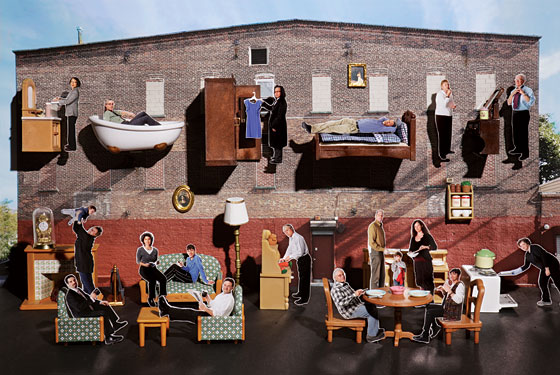 by Andy Douglas
by Andy Douglas
Years ago I lived in a housing cooperative in Austin, Texas, a bright yellow rambling Victorian house. The students, musicians and working people living there understood that community was both a human need and a joy. The diversity of the group made for interesting conversations.
On the other hand, it wasn’t for everyone; some saw the constant presence of others as an infringement on their privacy.
A group of Iowa Citians interested in living with a greater sense of community are pursuing a model called “co-housing,” which might address this issue of community/privacy.
I spoke with two members, Barbara Bailey and Del Holland. With others, in 2009 they began researching different types of housing communities, made several field trips around the region, and have come to the conclusion that the co-housing idea meets their group’s requirements. The model, which originated in Denmark, attempts to strike a balance: each family has its own home, but there are also shared common spaces.
The group’s website, iowacitycohousing.org, offers an idea of their goals: living in multi-generational community, with a balance of community and privacy, social and economic diversity, green buildings with a small carbon footprint, and an emphasis on alternative transportation.
The group has been searching for land within walking distance of downtown of at least three to four acres. Though such plots are scarce, they’ve found and made an offer on such a property, and are working to get financing. At the moment, five households have made a commitment; a dozen others have expressed interest.
Co-housing units in Denmark typically feature 24 to 30 households, and a common building. Several hundred are now in operation across the U.S., as are many more around the world.
“The relationships go beyond just sharing a wall, as in a condo,” said Holland. “There are opportunities to cook together, eat together. The sharing of material things appeals to me as an environmentalist. If I have a table saw, and my neighbor across the street has a table saw, they both may get used a few times a year. Why not share one? I don’t have to own everything.”
Bailey added, “The co-housing common space could have an extra bedroom everyone could use. It would be great for parents who visit once or twice a year.”
Yard work, maintenance, and childcare could all be shared, while the kids of the community can play together in a safe environment.
Co-housing residents aspire to “improve the world, one neighborhood at a time,” according to the website — which goes on to state, “Responsibilities are shared and decisions made collectively, usually by consensus. Leadership roles often rotate. As people join the group, each person takes on one or more roles consistent with his or her skills, abilities or interests.”
The city is supportive of the idea, Bailey said, and the group is now working with an architect, considering various housing designs. Of course, Holland noted, the more individual initiative in design there is, the more the cost goes up. There’ll probably be some basic standardization, with a few extra options.
Energy efficiency is also a big draw, said Holland.
“The site will determine whether we can use passive solar, geothermal, or photovoltaic. But the goal is to build in nearly zero use of energy.”
The group also hopes to offer affordable housing possibilities, whether in the form of downpayment assistance, or simply with smaller, more affordable houses. Rental could also be an option.
Once a co-housing developments gets going in Iowa City, this group is hoping that the idea will spread.
An informational meeting will be held Sept. 26 at the Iowa City Public Library.
Further Reading. Below are links to additional reading on the topic of co-housing.
- CoHousing.org. “Cohousing is a type of collaborative housing in which residents actively participate in the design and operation of their own neighborhoods. Cohousing residents are consciously committed to living as a community. The physical design encourages both social contact and individual space. Private homes contain all the features of conventional homes, but residents also have access to extensive common facilities such as open space, courtyards, a playground and a common house.” [More…]
- Pocket-Neighborhoods.net. “Pocket neighborhoods are clustered groups of neighboring houses or apartments gathered around a shared open space — a garden courtyard, a pedestrian street, a series of joined backyards, or a reclaimed alley — all of which have a clear sense of territory and shared stewardship. They can be in urban, suburban or rural areas. These are settings where nearby neighbors can easily know one another, where empty nesters and single householders with far-flung families can find friendship or a helping hand nearby, and where children can have shirttail aunties and uncles just beyond their front gate.” [More…]
- The Real Park Slope Co-op. Do you like your neighbors? Do you wish you knew their names? Would you want to make dinners with them, live with your door open, and vote on every group decision using a system of color-coded cards? These friendly people are building New York’s first co-housing community. Care to join them? [More…]
- Wikipedia Co-Housing. “A cohousing community is a type of intentional community composed of private homes supplemented by shared facilities. The community is planned, owned and managed by the residents – who also share activities which may include cooking, dining, child care, gardening, and governance of the community. Common facilities may include a kitchen, dining room, laundry, child care facilities, offices, internet access, guest rooms, and recreational features. Cohousing facilitates interaction among neighbors for social, practical benefits, economic and environmental benefit.” [More…]
__________
The above article originally appeared on the Press Citizen website (source). Because it contains the announcement of a public meeting, it was felt to be fair use to post it and promote it here.
